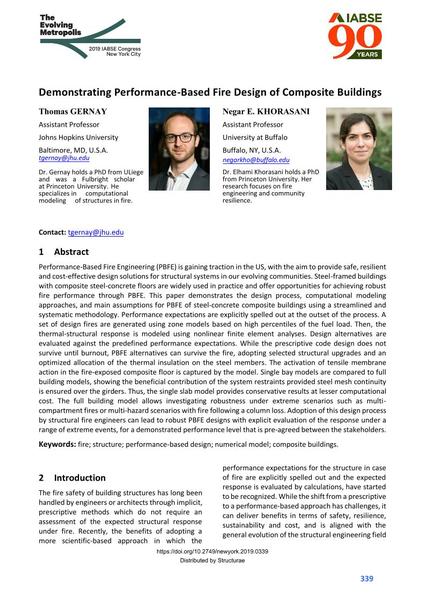Demonstrating Performance-Based Fire Design of Composite Buildings

|
|
|||||||||||
Détails bibliographiques
| Auteur(s): |
Thomas Gernay
(Johns Hopkins University)
Negar E. Khorasani |
||||
|---|---|---|---|---|---|
| Médium: | papier de conférence | ||||
| Langue(s): | anglais | ||||
| Conférence: | IABSE Congress: The Evolving Metropolis, New York, NY, USA, 4-6 September 2019 | ||||
| Publié dans: | The Evolving Metropolis | ||||
|
|||||
| Page(s): | 339-343 | ||||
| Nombre total de pages (du PDF): | 5 | ||||
| DOI: | 10.2749/newyork.2019.0339 | ||||
| Abstrait: |
Performance-Based Fire Engineering (PBFE) is gaining traction in the US, with the aim to provide safe, resilient and cost-effective design solutions for structural systems in our evolving communities. Steel-framed buildings with composite steel-concrete floors are widely used in practice and offer opportunities for achieving robust fire performance through PBFE. This paper demonstrates the design process, computational modeling approaches, and main assumptions for PBFE of steel-concrete composite buildings using a streamlined and systematic methodology. Performance expectations are explicitly spelled out at the outset of the process. A set of design fires are generated using zone models based on high percentiles of the fuel load. Then, the thermal-structural response is modeled using nonlinear finite element analyses. Design alternatives are evaluated against the predefined performance expectations. While the prescriptive code design does not survive until burnout, PBFE alternatives can survive the fire, adopting selected structural upgrades and an optimized allocation of the thermal insulation on the steel members. The activation of tensile membrane action in the fire-exposed composite floor is captured by the model. Single bay models are compared to full building models, showing the beneficial contribution of the system restraints provided steel mesh continuity is ensured over the girders. Thus, the single slab model provides conservative results at lesser computational cost. The full building model allows investigating robustness under extreme scenarios such as multi- compartment fires or multi-hazard scenarios with fire following a column loss. Adoption of this design process by structural fire engineers can lead to robust PBFE designs with explicit evaluation of the response under a range of extreme events, for a demonstrated performance level that is pre-agreed between the stakeholders. |
||||
| Mots-clé: |
structure
|
||||
